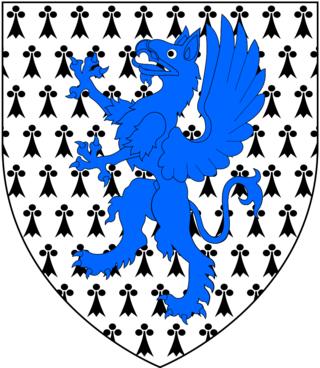
John Dolben (1625–1686) was an English priest and Church of England bishop and archbishop.

Lord Aston of Forfar was a title in the Peerage of Scotland. The barony was created on 28 November 1627 for Sir Walter Aston, Bt, who had been previously created Baronet of Tixall Hall, Staffordshire on 22 May 1611.
Walter Aston, 2nd Lord Aston of Forfar was the second and eldest surviving son of Walter Aston, 1st Lord Aston of Forfar, and Gertrude Sadleir, daughter of Sir Thomas Sadleir of Standon, Hertfordshire, and his second wife Gertrude Markham. Lady Aston was the granddaughter of the noted Elizabethan statesman Sir Ralph Sadler.
Walter Aston, 3rd Lord Aston of Forfar was the eldest son of Walter Aston, 2nd Lord Aston of Forfar, and his wife Lady Mary Weston, daughter of Richard Weston, 1st Earl of Portland. He is best remembered today as a fortunate survivor of the Popish Plot.

Walter Aston, 8th Lord Aston of Forfar was the son of Edward Aston and Anne Bayley.
Henry Tichborne, 1st Baron Ferrard, known as Sir Henry Tichborne, Bt, between 1697 and 1715, was an Irish peer.
Tichborne Aston was an Irish politician.

Francis Aungier, 1st Baron Aungier of Longford (1558–1632), also known as Lord Aungier, was the progenitor of the Earldom of Longford, member of the House of Lords, Privy Councillor for Ireland and Master of the Rolls in Ireland under James I and Charles I.

Thomas Keightley (1650–1719) was an English courtier and official in Ireland, who as brother-in-law to Henry Hyde, 2nd Earl of Clarendon played a role in the abdication of James II.
Henry Seymour of Langley, was an English courtier who supported the Royalist cause in the English Civil War and after the Restoration sat in the House of Commons from 1660 to 1681.
Sir William Methold was an English-born judge in seventeenth-century Ireland, who held office as Chief Baron of the Irish Exchequer.
Sir Richard Pyne was an Irish landowner, barrister and judge. He held office as Lord Chief Justice of Ireland from 1695-1709.

John Bathe was an Irish barrister and judge. He was a member of a famous legal dynasty, and had a distinguished career under the Tudors, holding office as Solicitor General for Ireland and Chief Justice of the Irish Common Pleas.
Sir James Dowdall was an Irish judge of the Elizabethan era who briefly held office as Lord Chief Justice of Ireland. He should not be confused with James Dowdall, the Catholic martyr, who was his cousin.
Richard Segrave (c.1540–1598) was an Irish judge, remembered chiefly for sitting in judgement on his colleague Nicholas Nugent, who was the only Irish judge ever to be hanged for treason by the Government which appointed him.
Sir William Sambach was an English-born lawyer and politician of the seventeenth century who spent much of his career in Ireland, but was driven back to England by the political turmoil of the 1640s, and died there.
Sir Jerome Alexander (c.1585–1670) was an English-born barrister, judge and politician, who spent much of his career in Ireland, and became a substantial Irish landowner. He was a noted benefactor of Trinity College Dublin. As a judge, he was so ruthless in securing guilty verdicts in criminal cases, and in imposing the death penalty on the guilty party, that for many years after his death "to be Alexandered" was an Irish synonym for being hanged.
Thomas Stockton (1609–1674) was an English-born judge who held office in seventeenth-century Ireland.
Garret Moore, 1st Viscount Moore PC (I) was an Anglo-Irish politician and peer.
Sir John Lyndon was an Irish judge and politician of the seventeenth century. He was the first holder of the office of Third Serjeant-at-law, which was created especially for him, apparently as a "consolation prize" for not being made a High Court judge the first time he sought that office. He was also Recorder of Carrickfergus for many years, a position held by several members of the Lyndon family.





